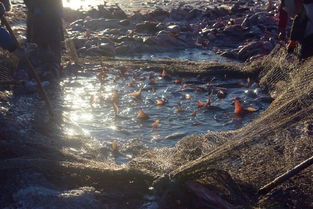Content:
Winter, with its crisp air and tranquil river landscapes, offers a unique and rewarding experience for anglers. The calmness of the water and the sparse presence of other anglers make it an ideal time to hone your river fishing skills. However, the cold temperatures and changing water conditions can make it challenging to catch fish. In this article, we will delve into the essential techniques for river fishing during the winter months, focusing on how to increase your chances of success.
Understanding Winter River Conditions
Before we dive into the techniques, it's crucial to understand the unique conditions that winter brings to river environments. Cold weather slows down the metabolism of fish, leading them to become more selective about their food sources. Additionally, water temperatures drop, which can affect the fish's behavior and distribution. Here are some key points to consider:
Water Temperature: Fish are most active in water temperatures ranging from 50°F to 70°F (10°C to 21°C). During winter, water temperatures tend to be colder, so you'll need to adjust your approach accordingly.
Fish Movement: In colder waters, fish tend to move to deeper, warmer areas of the river. Look for spots where the river bottom slopes down, as these areas often hold fish during the winter.

Oxygen Levels: Cold water holds less oxygen than warm water. Therefore, fish will often congregate in areas where the water is flowing slower and oxygen levels are higher.
Choosing the Right Equipment
The right equipment can make a significant difference in your winter river fishing success. Here's what you should consider:
Rod and Reel: Use a light to medium-action rod, as it provides better sensitivity and control. A spinning reel is often preferred due to its ease of use in cold weather.
Line: A monofilament line with a lower rating (like 4-6 pounds) is suitable for winter river fishing. This allows for a better presentation without spooking the fish.
Lures and Baits: In the winter, fish are less active, so it's best to use slower-moving lures or natural baits that mimic prey more effectively. Soft plastics, small jigs, and live bait like worms or minnows can be effective.
Winter River Fishing Techniques
Now that you have the right equipment, let's explore some fishing techniques that can help you catch more fish during the winter:
Timing: Fish are often most active during the first few hours of daylight and right before sunset. This is when the water temperature is warmer and the fish are more likely to feed.
Location: Focus on areas with structure, such as rocks, logs, and weed beds. These spots provide cover and warmth for fish, making them more likely to hold fish during the cold winter months.
Depth: As mentioned earlier, fish tend to move to deeper waters during the winter. Cast your lures or baits to these depths and let them sink slowly to mimic natural prey.
Rigging: For live bait, use a simple rig with a hook and a split shot. For artificial lures, a Carolina rig or a Texas rig can be effective. These rigs allow your bait to move naturally and can trigger strikes from fish that are less active.
Patience: Winter fishing requires patience. It may take longer to get a bite, so be prepared to wait and be consistent with your efforts.
Adjustments: Be ready to make adjustments based on the weather and water conditions. If the wind picks up or the water gets murky, fish may become more skittish, and you may need to change your approach.
Safety: Always prioritize safety when fishing in cold weather. Dress in layers to stay warm, wear waterproof boots, and be aware of the weather forecast and ice conditions if you're fishing on a frozen river.
By applying these techniques and understanding the unique challenges of winter river fishing, you can increase your chances of success and enjoy a peaceful day on the water. Remember, the key is to be patient, adapt to the conditions, and use the right techniques to attract and catch fish during the colder months. Happy fishing!












